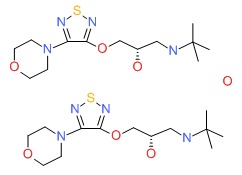NCBI Bookshelf. A service of the National Library of Medicine, National Institutes of Health.
LiverTox: Clinical and Research Information on Drug-Induced Liver Injury [Internet]. Bethesda (MD): National Institute of Diabetes and Digestive and Kidney Diseases; 2012-.

LiverTox: Clinical and Research Information on Drug-Induced Liver Injury [Internet].
Show detailsOVERVIEW
Introduction
Timolol is a nonselective beta-adrenergic receptor blocker that is widely used for the therapy of hypertension, angina pectoris and prevention of vascular headaches. Timolol has yet to be convincingly associated with clinically apparent liver injury and is often used in patients with liver disease and cirrhosis.
Background
Timolol (tim' oh lol) is a nonselective beta-blocker, acting on both beta-1 and beta-2 adrenergic receptors. Beta-1 adrenergic blockade reduces the heart rate and myocardial contractility by slowing the AV conduction and suppressing automaticity. Beta-2 blockade also affects peripheral vascular resistance and can cause bronchospasm and hypoglycemia. Timolol is indicated for the management of hypertension, angina pectoris, cardiac arrhythmias and reduction in the risk of cardiovascular mortality after myocardial infarction. Timolol is also used for the prevention of migraine amd vascular headaches and for lessening the risk of recurrent variceal hemorrhage in patients with cirrhosis and portal hypertension. Timolol was approved for use in the United States in 1995 and is still in wide use. Timolol is available in tablets of 5, 10 and 20 mg in generic forms and formerly under the trade name Blocadren. In addition, timolol is available in an ophthalmic formulation for therapy of ocular hypertension and glaucoma. The typical initial oral dose of timolol in adults is 10 mg twice daily, with subsequent dose modification based upon clinical response and tolerance, the average total daily maintenance dose being 10 to 60 mg. Common side effects of timolol include bradycardia, hypotension, fatigue, dizziness, depression, memory loss, impotence, cold limbs and less commonly severe hypotension, heart failure and bronchospasm. As with all beta-blockers, sudden withdrawal can trigger rebound hypertension. Beta-blockers are contraindicated in patients with asthma, bradycardia and heart failure and should be used cautiously in the elderly and in patients with diabetes.
Hepatotoxicity
Mild-to-moderate elevations in serum aminotransferase levels occur in less than 2% of patients on timolol and are usually transient and asymptomatic, resolving even with continuation of therapy. Despite its wide spread use, timolol has not been convincingly linked to instances of clinically apparent liver injury. Other beta-blockers have been implicated in rare instances of acute liver injury with a latency to onset ranging from 2 to 24 weeks, a hepatocellular pattern of serum enzyme elevations and a mild, self-limiting course without evidence of hypersensitivity or autoimmune reactions.
Likelihood score: E (unlikely cause of clinically apparent acute liver injury).
Mechanism of Injury
Timolol undergoes extensive metabolism by the liver and is excreted in the urine as inactive metabolites. The reason why timolol rarely causes liver injury is unknown; other beta-blockers with similar chemical structures have been linked to cases of clinically apparent, idiosyncratic liver injury.
References to the safety and potential hepatotoxicity of timolol are provided in the overview on Beta-Adrenergic Receptor Antagonists, last updated in June 2019.
Drug Class: Beta-Adrenergic Receptor Antagonists
PRODUCT INFORMATION
REPRESENTATIVE TRADE NAMES
Timolol – Generic, Blocadren®
DRUG CLASS
Beta-Adrenergic Receptor Antagonists
Product labeling at DailyMed, National Library of Medicine, NIH
CHEMICAL FORMULA AND STRUCTURE
| DRUG | CAS REGISTRY NUMBER | MOLECULAR FORMULA | STRUCTURE |
|---|---|---|---|
| Timolol | 91524-16-2 | C13-H24-N4-O3-S.1/2H2-O |
 |
- PubChem SubstanceRelated PubChem Substances
- Review Nadolol.[LiverTox: Clinical and Researc...]Review Nadolol.. LiverTox: Clinical and Research Information on Drug-Induced Liver Injury. 2012
- Review Propranolol.[LiverTox: Clinical and Researc...]Review Propranolol.. LiverTox: Clinical and Research Information on Drug-Induced Liver Injury. 2012
- Review Pindolol.[LiverTox: Clinical and Researc...]Review Pindolol.. LiverTox: Clinical and Research Information on Drug-Induced Liver Injury. 2012
- Review Beta Adrenergic Blocking Agents.[LiverTox: Clinical and Researc...]Review Beta Adrenergic Blocking Agents.. LiverTox: Clinical and Research Information on Drug-Induced Liver Injury. 2012
- Pharmacokinetics, mechanisms of action, indications, and adverse effects of timolol maleate, a nonselective beta-adrenoreceptor blocking agent.[Pharmacotherapy. 1981]Pharmacokinetics, mechanisms of action, indications, and adverse effects of timolol maleate, a nonselective beta-adrenoreceptor blocking agent.Dunn FG, Frohlich ED. Pharmacotherapy. 1981 Nov-Dec; 1(3):188-200.
- Timolol - LiverToxTimolol - LiverTox
Your browsing activity is empty.
Activity recording is turned off.
See more...